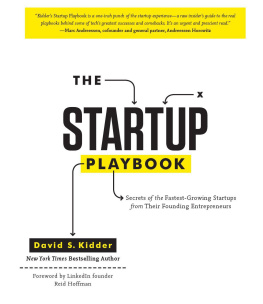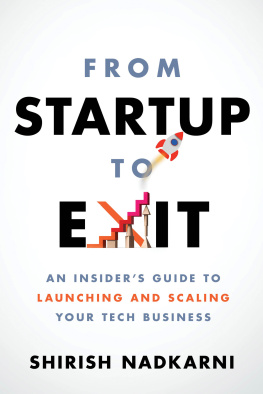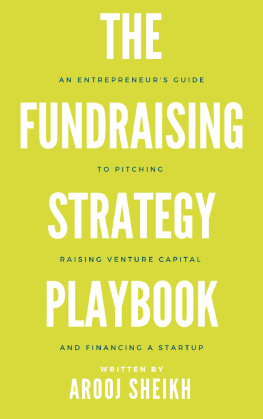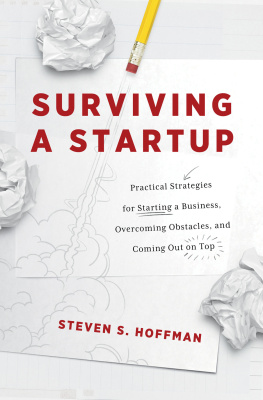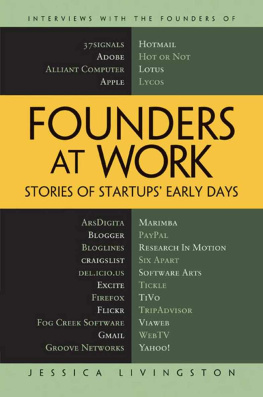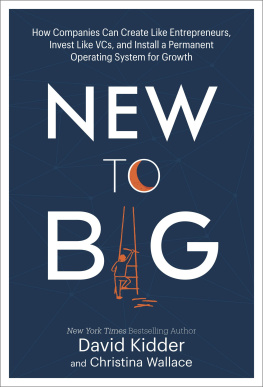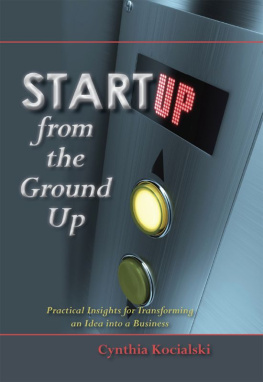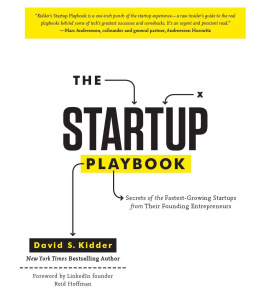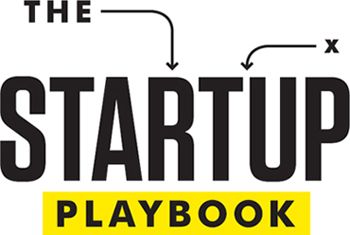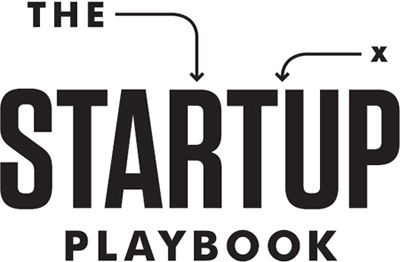
Secrets of the Fastest-Growing Startups
from Their Founding Entrepreneurs
David S. Kidder
New York Times Bestselling Author
With Hanny Hindi

Foreword by LinkedIn founder Reid Hoffman

TEXT COPYRIGHT 2012 BY DAVID S. KIDDER.
FOREWORD COPYRIGHT 2012 BY REID HOFFMAN.
ILLUSTRATIONS COPYRIGHT 2012 BY MARON RESUR.
ALL RIGHTS RESERVED. NO PART OF THIS BOOK MAY BE REPRODUCED IN ANY FORM WITHOUT WRITTEN PERMISSION FROM THE PUBLISHER.
LIBRARY OF CONGRESS CATALOGING-IN-PUBLICATION DATA AVAILABLE.:
ISBN 978-1-4521-2404-9
DESIGNED BY MINE
CHRONICLE BOOKS LLC
680 SECOND STREET
SAN FRANCISCO, CALIFORNIA 94107
WWW.CHRONICLEBOOKS.COM
DEDICATION
This book is for my most important startup and the center of my life and heart, my family: Johanna and my three sons, Jack, Stephen, and Lucas.
I hope this book inspires and serves you as it has me in living out the purpose of our family; to utilize our God-given gifts to make an extraordinary, positive impact on people and the world.
CONTENTS
REID HOFFMAN
FOREWORD
REID HOFFMAN
Entrepreneurs are pioneers. In creating new businesses, they venture out across the market-scape to discover and build new products and services. Like pioneers, these journeys are frequently long, lonely, and risky. But, also like pioneers, these journeys are essential for the growth of our societyto build new economies, new ecosystems of work and life.
This book offers lessons in pioneering from key entrepreneurs. Pioneers needed to know locations, weather, supply logistics, travel, and various technologies like maps, navigation, and transport. Entrepreneurs need to understand markets, industry transformations, finance, business operations, and various technologies involved in products, services, and modern business. Pioneers and entrepreneurs have to assemble networks of support: teams, finance, and expertise. When successful, both set up new lives and work opportunities for people. Pioneers establish towns and territories; entrepreneurs establish companies and other institutions.
Both leave the established order to build something new. They have many reasons: a vision, a mission, love of a product, or are simply compelled. But leaving the established order is hard. You leave significant infrastructure and support behind. And, you take real risks journeying into the unknown.
We are all familiar with heroic stories of entrepreneurs. These stories tell of easy, quick, or inevitable success. In reality, there are almost always massive challenges, delays, setbacks, risks, and uncertainties. Indeed, entrepreneurs and pioneers have to believe that their journeys will be successful; they would never have set out without that belief. But the journey is almost always hard. Here, entrepreneurs share key lessonsin the hope that those who set out on their own will make new mistakes rather than their old ones. They also hope to make the journey somewhat less lonely by sharing their experiences. I frequently describe entrepreneurship as jumping off a cliff and assembling an airplane on the way down. This book is about airplane assembly, weather patterns, and flying intelligently.
Good Luck.
INTRODUCTION
Starting a company is a staggering journey into the unknown. It is simultaneously thrilling and terrifying. You are setting yourself up for a spectacular challenge and the likelihood of failure is high. It is essential to prepare, and to have a sober respect for the experience. In Outliers, Malcom Gladwell estimates that it takes over 10,000 hours of dedicated training to develop expertise in any field. This is the commitment you are making when you start a company; become an expert startup founder.
Developing ones company-creation thesis requires a never-ending and humbling commitment. The simple mission is to truthfully reflect and understand, persistenty press on, and perfect. Its the shift from defining ourselves as who we think we are to who we are becoming. This book is the latest chapter in my own journey of becoming the best entrepreneur I am capable of being.
In building my last two companies, I created what Ive come to define as a startup playbook: an evolving collection of the core ideologies, beliefs, tools, and methods that reveal a model of building companies, from concept tohopefullythriving reality. I promise all my team members that they will have the chance to become complete startup executives; that they will know and experience the successes and failures of the entire startup journey; and that our startup playbook will remain the companys operating system and the foundation that we will all build on year after year. However, these past few years, I realized that I needed to upgrade my playbook, largely because my most recent company was rapidly scaling in complexity, people, partners, products, culture, and many other dimensions. The playbook I began with simply wasnt robust enough to capture all the extremes of taking a company from its fledgling roots, when you are solving five to ten challenges at a time, to a much larger company, where you are suddenly required to juggle hundreds of problems simultaneously, often instantaneously. I decided it was time to hit the reset button and pull in as much knowledge as quickly as I could. I reached out to my most admired friends and contacts, many of whom are considered among the best entrepreneurs in their fields. Some I have known for most of my career, while others I was meeting for the first time. I wanted their startup playbooks in order to rebuild mine. Now, I am sharing their playbooks with you.
Building a startup will be the home-ownership of the next century.
The entrepreneurs I turned to have experience in as many varied sectors as I could gain access to in both the nonprofit and for-profit worldsfrom technology and finance to flowers, drinks, shoes, spaceships, and pantyhose. All of them are game-changers; many are billionaires, whether in the realm of ideas, publishing, media, or philanthropy. When we spoke, I tried to get them to answer two central, burning questions:
1. What are your most vital theses for creating successful, scaling startups?
2. What are the key practices, behaviors, and ideas that power a startups growth in its first five years?
These questions were designed to be tight enough to focus the conversations into straightforward, iconic ideas, while also being loose enough to let the interviews touch on topics ranging from product development to team building and HR; from investors to culture, design, marketing, finance, crisis management, and more. I sought to discover the critical competitive behaviors that helped these respected (often legendary) founders and visionaries create the leading companies in their markets.
In the end, for the purposes of the book, we focused on some forty of the nearly fifty interviews we completed either in person or via remote video. In each interview, we followed a scripted set of questions devised to tease out the entrepreneurs guiding theses. Throughout the interviews, I took detailed notes and probed for the living ideas that their playbooks comprise, highlighting their best advice across a broad set of startup challenges and personal journeys. We wanted these entrepreneurs to tell us how it really is; boy, did they deliver.
Next page
